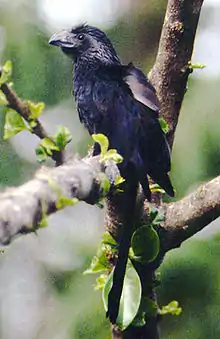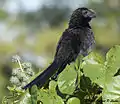Ani (bird)
The anis are the three species of near-passerine birds in the genus Crotophaga of the cuckoo family. They are essentially tropical New World birds, although the range of two species just reaches the United States. Recent DNA evidence places them in the group Crotophaginae.[1][2]
| Ani | |
|---|---|
 | |
| Groove-billed ani, Crotophaga sulcirostris | |
| Scientific classification | |
| Kingdom: | Animalia |
| Phylum: | Chordata |
| Class: | Aves |
| Order: | Cuculiformes |
| Family: | Cuculidae |
| Subfamily: | Crotophaginae |
| Genus: | Crotophaga Linnaeus, 1758 |
| Type species | |
| Crotophaga ani | |
Unlike some cuckoos, the anis are not brood parasites, but nest communally, the cup nest being built by several pairs from 2–6 m high in a tree. A number of females lay their eggs in the nest and then share incubation and feeding.
The anis are large black birds with a long tail and a deep ridged black bill. Their flight is weak and wobbly, but they run well, and usually feed on the ground.
These are very gregarious species, always found in noisy groups. Anis feed on termites, large insects and even lizards and frogs. The claim that they will remove ticks and other parasites from grazing animals has been disputed; while there is no doubt that anis follow grazing animals in order to catch disturbed insects and will occasionally eat fallen ticks, there is no proof that they remove ticks from the animals' bodies.
Fossils of two ani species have been found from Pleistocene rocks, dated to between 1.8 million and 10,000 years ago.[3]
Etymology
In Merriam-Webster dictionary online the word ani is derived from New Latin possibly partly incorrect rendering of the native name of the bird in Brazilian Tupi language.[4] Etymonline says it is in English from Spanish of Portuguese and ultimately from Tupi.[5]
Species
| Image | Scientific name | Common Name | Distribution |
|---|---|---|---|
_(5145862597).jpg.webp) | Crotophaga major | Greater ani | from Panama and Trinidad through tropical South America to northern Argentina. |
 | Crotophaga ani | Smooth-billed ani | Florida, the Bahamas, the Caribbean, parts of Central America, south to western Ecuador, Brazil, and northern Argentina. |
 | Crotophaga sulcirostris | Groove-billed ani | southern Texas, central Mexico and The Bahamas, through Central America, to northern Colombia and Venezuela, and coastal Ecuador and Peru |
References
- Avise JC, Nelson WS, Sibley CG (June 1994). "Why one-kilobase sequences from mitochondrial DNA fail to solve the Hoatzin phylogenetic enigma". Mol. Phylogenet. Evol. 3 (2): 175–84. doi:10.1006/mpev.1994.1019. PMID 8075835.
- Payne, R.B. (2005). The Cuckoos. Oxford University Press.
- Brodkorb, (1971). "Catalogue of fossil birds: part 4 (Columbiformes through Piciformes)." Bulletin of the Florida State Museum, 15: 163-266.
- "Definition of ANI". www.merriam-webster.com. Retrieved 2020-04-25.
- "ani | Origin and meaning of ani by Online Etymology Dictionary". www.etymonline.com. Retrieved 2020-04-25.